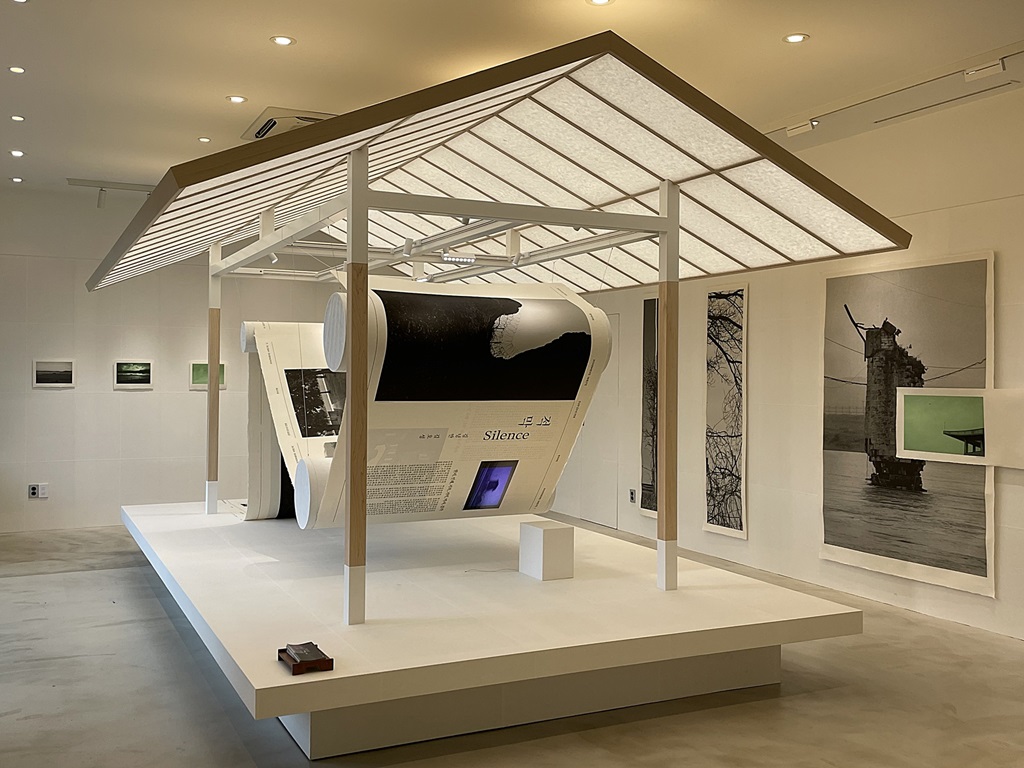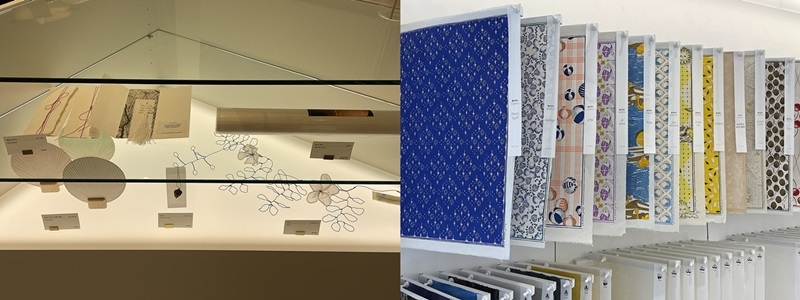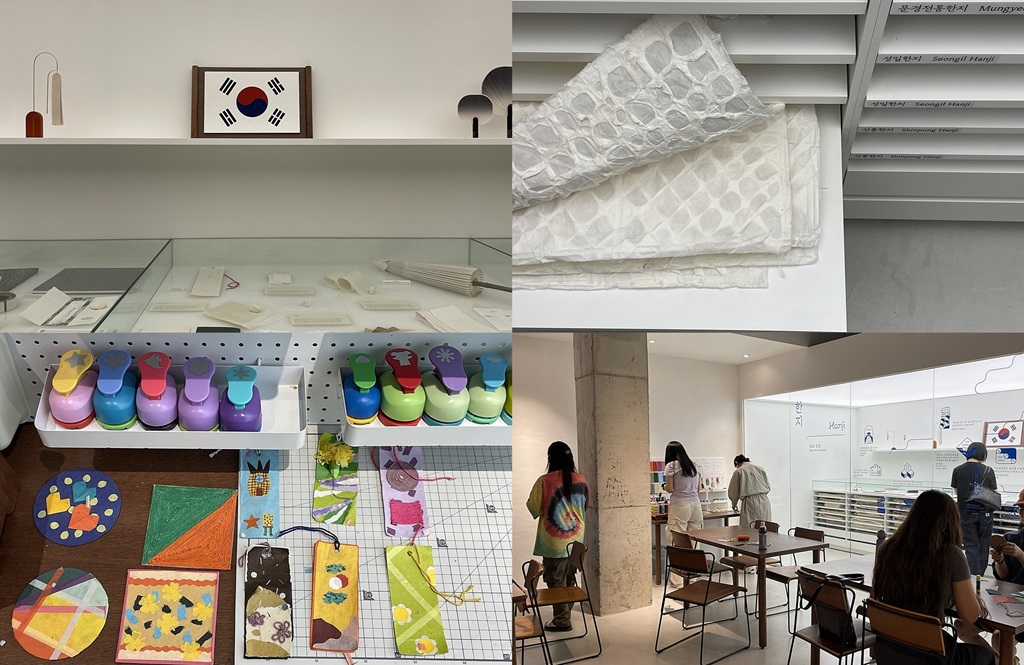
장마가 시작된 7월 초. 안국역 지하철 2번 출구에서 나와 습하고 더운 날씨를 피해 코리아넷 기자가 한 건물에 도착했다. 입구로 들어서니 시원한 에어컨 바람이 땀을 식혀준다. 언뜻 보아도 한눈에 다 담기는 정갈하고 아담한 공간이다. 마음을 차분하게 하는 잔잔한 음악도 흐른다. 소형 갤러리를 연상케 하는 이곳은 바로 ‘한지가헌’이다.
Early July sees the rainy season begin. A Korea.net staff writer leaves Exit 2 at Anguk Station in Seoul and arrives at a building to escape the humid and hot weather. As soon as she enters, a cool breeze from the air conditioner cools off her sweat. A single glance shows a neat and compact place with soft and calming music flowing. This facility resembling a small gallery is Hanji House, named after the nation’s traditional paper.
한지가헌은 (옛)한지문화산업센터의 새 이름. 한국의 전통 유산인 한지를 국내외에 널리 알리기 위해 지난 2020년 5월 개관했다. 한국공예·디자인문화진흥원(공진원) 황문희 주임은 “기존 센터가 가진 공간의 비효율성을 극복하고 기능을 확대하기 위해 공간을 개편함과 동시에 한지가헌으로 개명했다”며 “영문 이름도 외국인들이 쉽게 알아볼 수 있도록 ‘Hanji House’라 붙였다”고 설명했다.
Formerly Hanji Culture and Industry Center, the venue was renamed in May 2020 to promote Hanji, a traditional heritage, both at home and abroad. “We reorganized the space and renamed it Hanjigaheon (Hanji House) to overcome the spatial inefficiency of the center and expand its functions,” said Hwang Moonhee, project manager at the Korea Craft and Design Foundation (KCDF). “We selected the English name Hanji House to allow easy recognition by foreign visitors.”
현재 1층 중앙과 벽면에는 ‘적막:세대와 차이를 기억하는 방법(Silence:The Memory of Generation)’ 전시가 진행 중이다. 부자지간인 김녕만, 김호성 사진작가의 사진을 한지에 인쇄하는 형식의 협업 전시다. 한지가헌의 개막식이 열린 지난달 18일에 맞춰 시작해 오는 8월 27일까지 선보인다. 계속해 9월과 11월 새로운 전시가 시민 곁을 찾아간다. 공진원 정연주 팀장은 “외국인 관람객을 위한 영어, 일본어, 중국어 해설을 제공하고 있다”고 말했다.
The collaborative exhibition “Silence: The Memory of Generation” at the center of the first floor and its walls feature works on Hanji prints by photographers Nyeong-man and Kim Ho-sung, who are father and son. Opened on June 18, the day of the opening ceremony for Hanji House, the exhibition runs through Aug. 27. New displays are scheduled to be added in September and November. Jung Yeun-Ju, another KCDF project manager, said guidance in English, Japanese and Chinese is provided for foreign visitors.

1층을 둘러본 뒤 지하 1층으로 내려갔다. 지하 1층은 총 세 개의 공간으로 분리됐다. 직접 찍은 사진을 한지에 출력할 수 있는 작은 사진관, 체험 프로그램 또는 워크숍이 열리는 한지배움터, 그리고 한지 관련 자료 보관실(아카이브실)이다.
After browsing on the first floor, the writer headed down to the first basement level, which was divided into three sections. A small photo studio allowed visitors to print on Hanji the photos they took, a Hanji Learning Center hosted interactive programs and workshops; and an archive room featured Hanji-related resources.
아카이브실에는 전국 18개 한지 공방에서 제작되는 다양한 한지와 대표 작품이 전시돼 있다. 이 공방은 국가 또는 시도 무형유산으로 지정된 한지장들이 운영하는 곳이다. 공진원 양솔비 주임은 각각의 공방에 대해 “색한지를 제작하는 곳도 있고, 한지 위에 칠을 해 두꺼운 한지를 제작하는 곳도 있다”고 했다. 관람객이 커다란 서랍장을 한 칸 한 칸씩 꺼내 한지를 직접 만져보며 각각의 특색과 차이점을 비교해 볼 수 있다.
The archive room displayed Hanji and leading works made at 18 Hanji workshops nationwide run by Hanji masters designated national or municipal intangible cultural heritage. Project manager Yang Solbi said on each workshop, “Certain places make colored Hanji and others thick Hanji by coloring the paper.” Visitors can take out each large drawer and touch Hanji to compare the characteristics and differences of each paper.
하지만 공방들이 처한 안타까운 현실적 문제도 존재한다. 황 주임은 “작년까지 19개였던 공방이 올해 18개로 줄었다”며 “장인들의 연령대가 높은 편인데 공방을 이어갈 사람까지 없어 매년 감소하는 추세”라고 안타까워했다. 한국의 전통 한지를 향한 관심뿐 아니라 이를 보호하고 계승해야 하는 필요성을 강조한 말이렷다.
Hanji workshops, however, face practical problems. “The number of workshops has dipped from 19 last year to 18 this year,” Hwang said. “The artisans are older but nobody succeeds them, so their number is decreasing every year.” She urged the need not only for interest in Hanji but also for protecting and passing it on.
아카이브실을 둘러보고 나오니 한지배움터는 이미 체험 프로그램에 참여하고 있는 사람들로 가득 찼다. 이곳은 전통 한지로 열쇠고리, 책갈피 등 작은 소품을 만드는 프로그램을 예약제로 운영한다. 제작에 필요한 도구가 놓인 탁자엔 프로그램 안내문이 영어로 붙어있다. 외국인도 쉽게 참여할 수 있겠다. 네이버를 통해 예약 할 수 있다. 참가비는 무료다.
After exploring the archive room, the writer walked into Hanji Learning Center, which was packed with visitors attending a reservation-only interactive program. They made small items such as keychains and bookmarks out of Hanji.
The table there had the tools needed to make items and a brochure in English on the program, making it easy for foreign visitors to participate. Reservations for the free program can be made on Naver, Korea’s largest web portal.

한편 국가유산청은 지난 3월 31일 ‘한지제작의 전통지식과 기술 및 문화적 실천’을 유네스코 인류무형유산 등재 신청서를 유네스코 본부에 제출했다. 등재 여부는 오는 2026년 12월에 열리는 제21차 유네스코 무형유산보호협약 정부간위원회에서 최종 결정된다.
Earlier on March 31, the Korea Heritage Service applied to register traditional knowledge, technology and cultural practices of Hanji production with UNESCO’s Intangible Cultural Heritage of Humanity. The final decision on inscription will come in December 2026 at UNESCO’s Convention for the Safeguarding of the Intangible Cultural Heritage.
황 주임은 유네스코 인류무형유산 등재 노력의 일환으로 “한국공예·디자인문화진흥원은 전통 한지를 국외에 알릴 수 있도록 영상을 제작해 확산할 예정”이라며 “이 공간에서 해외 교류 공동연수(워크숍)을 개최하는 것도 전통 한지 문화를 국내뿐 아니라 국외에 널리 알리기 위한 것”이라고 덧붙였다.
“The Korea Crafts and Design Foundation will make and disseminate a video to promote Hanji abroad,” Hwang said. “We will hold joint international exchange workshops at this place.” “Our goal is to promote traditional Hanji culture not only at home but also overseas.”
* 한지가헌 방문객을 위한 팁! Tips for visiting Hanji House
– 1층 중앙에 위치한 전시대는 단순 전시대가 아니다. 한지로 마감한 마루이니 편히 앉아 작품을 감상해 보길 추천한다. 마루뿐 아니라 벽면과 조명도 한지로 제작한 또 하나의 작품이다. 한지가헌의 매력을 충분히 느껴보길 바란다.
The exhibition stand at the center of the first floor is not merely for display. The floor is made of Hanji, so sitting comfortably to look at the works is recommended. Not only the floor but the walls and lights are also made of Hanji to get the full experience of Hanji House.
– 작은 사진관에는 의자, 촬영용 조명판, 카메라까지 없는 게 없다. 월요일을 제외한 나머지 요일에 모두 세 번(오후 2시, 4시, 6시) 30분씩 열린다. 매주 수요일은 문화가 있는 수요일로 저녁 8시까지 연장 운영한다. 가격은 장당 1만5000원. 두 명이 같이 찍어 두 장을 출력할 경우 5000원의 추가 비용이 발생한다. 내외국인 상관없이 한복을 입고 방문하면 1 만원으로 할인받을 수 있다. 네이버 예약을 통해 예약이 가능하다.
The small photo studio has everything from chairs, lighting boards specifically for photo taking and cameras. It is open at 2 p.m., 4 p.m. and 6 p.m. for 30 minutes each daily except Monday. Every Wednesday is “Culture Wednesday,” with extended hours to 8 p.m. The price is KRW 15,000 per photo. If two people each take a photo together and print two, the additional charge is KRW 5,000. Visitors regardless of nationality can get KRW 10,000 off by wearing Hanbok (traditional costumes). Reservations can be made on Naver.
– 전시와 체험 프로그램 등 자세한 내용은 한지가헌 공식 누리집(https://www.kcdf.or.kr/hanji/) 또는 인스타그램(@hanji.house)에서 확인할 수 있다. For more information on the exhibition’s programs, visit Hanji House’s official website (www.kcdf.or.kr/hanji) or Instagram account (@hanji.house).
서울 = 글·사진 이다솜 기자 dlektha0319@korea.kr
By Lee Dasom, dlektha0319@korea.kr
